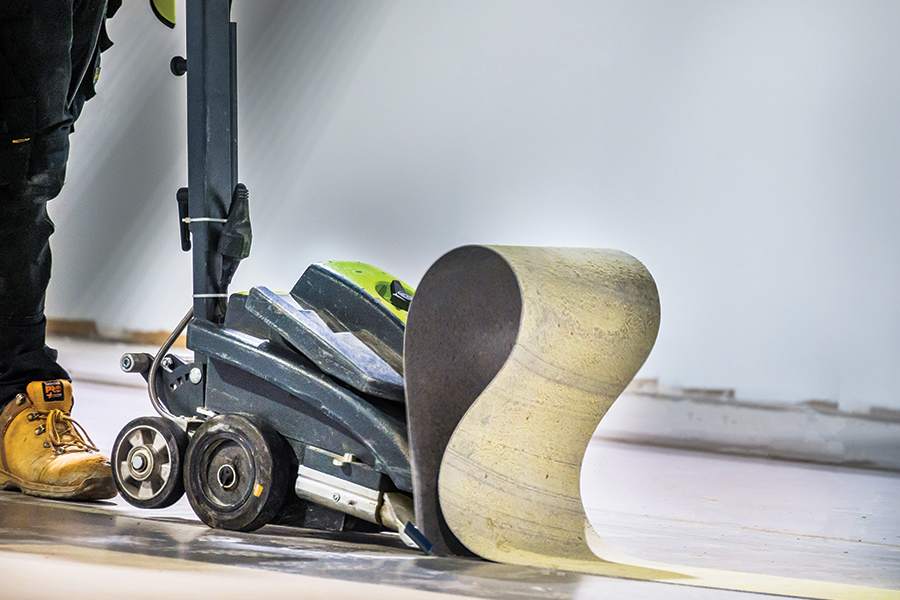SUSTAINABILITY should be open to being interpreted differently by individual businesses. While the definition of ‘sustainability’ may not have changed much over the years, people’s understanding of it has. In recent years, the conversation has shifted towards creating a stronger circular economy, moving away from the traditional ‘take, make, use and dispose’ linear model.
For the construction industry in particular, this is proving to be a difficult challenge. In 2018 a study by Defra showed construction, demolition and excavation (CDE) was responsible for an astonishing 59% of the million tonnes of waste generated in the UK that year.
In its own words, here is Tarkett’s approach:
At Tarkett we decided it was time to make a change and defined circularity as one of the key pillars in our sustainability DNA, to develop a regenerative method of production to prevent damage to our planet, also known as the circular economy.
Unlike the traditional linear model based on a consumer throw away pattern, the Circular Economy is designed to eliminate waste to circulate. The circular economy is based on three key principles, designing out waste and pollution, circulating products and materials at their highest value and regenerating natural resources.
This has led to significant changes in the way manufacturers make products, which has encouraged specifiers to have an eco-conscious approach when selecting products for consumers use. While these changes take place, there is still a missing link in being able to fully close the loop.
Guided by Cradle to Cradle principles and through significant investment and ground-breaking innovation, Tarkett is leading the transition to a circular economy in the flooring industry.
The Cradle to Cradle Methodology challenges manufacturers to re-design their products from the outset, eliminating any waste and harmful ingredients and chemicals from their products. It also champions the use of recycled raw materials, renewable energy and carbon management, water stewardship and social fairness.
Tarkett has the widest selection of Cradle to Cradle Certified products on the flooring market, with more than 20 certificates covering over 100 different individual products.
Having identified the barriers to placing products on the market that are truly circular, Tarkett continued to develop the solutions to recycle post-installation and post-consumer flooring waste – and we have achieved it.
At one of our nine dedicated recycling centres, Tarkett can now recycle post-installation waste of all our commercial vinyl and linoleum, and post-consumer flooring waste of carpet tiles, homogenous vinyl, linoleum, loose-lay sheet vinyl and loose-lay LVT. This is all encompassed in our ReStart programme, the hassle-free flooring takeback service.
In 2021, Tarkett released the Circular Selection brochure – a collection of new and existing products which are defined as circular – utilising high levels of recycled content and are 100% closed-loop recyclable at end-of-life at one of our recycling centres, collected via our ReStart programme. This offers customers the choice of specifying truly sustainable products.
As well as being able to recycle, Tarkett upcycles waste materials from other industries such as chalk, fishing nets and polyvinyl butyral (PVB) to give old materials a new lease-of-life to continue to circulate in the ‘closed loop’.
Of course, the focus of many businesses, organisations and government is on climate change and the impact that their operations have, directly or indirectly. Many specifiers are now looking at carbon neutral options. While carbon neutral products can be beneficial, the ‘neutrality’ is often achieved through carbon off-sets, which has faced criticisms, including giving manufacturers the right to pollute and avoiding real carbon reductions, these products are then not able to be recycled post-consumer, so are likely to be incinerated at their end-of-life, thus emitting CO2 back into the atmosphere.
‘Product waste is one of the main contributors to greenhouse gas emissions, adopting a circular approach is essential in achieving net zero,’ says Ross Dight, technical & sustainability director at Tarkett.
When Tarkett take back flooring through the ReStart Programme it prevents products from being sent to landfill and incineration by recycling valuable resources back into new Tarkett flooring. This saves virgin raw material extraction and prevents harmful fumes being let out into the atmosphere, which contributes to reducing CO2 emissions.
Tarkett Climate benefit’s from Recycling Report highlights how you can save about 10kgs CO2-eq, per m2 of post-use DESSO Eco-Base carpet tiles, 17kgs CO2-eq per m2 of post-use loose-lay LVT, 12.4kgs CO2 per m2 of post use loose-lay sheet vinyl and 5.4kgs CO2-eq per m2 of post-use linoleum.
As an example, in 2022, Tarkett worked with London based hospital, UCLH where a total 6.4 tonnes of post-use and post-installation flooring waste was recovered from the site, saving an impressive 23 tonnes CO2-eq when recycled back into new Tarkett floors.
It’s clear that harnessing circularity and applying a regenerative approach will certainly make our planet a better place.
Recycling is crucial to reduce greenhouse gas emissions and the reliance on virgin raw materials which will not only prevent the extraction of precious and scarce minerals to eliminate the amount of waste we produce, it will allow eco-systems to flourish too.
To find out more information on Tarkett’s Circular Selection try the new carbon calculator by scanning the QR code.
01233743659
sales@tarkett.com
www.tarkett.com
Tarkett leading the transition to a circular economy in the flooring industry, reducing CO2 emissions and promoting sustainability
Please click to view more articles about
> Tarkett <

